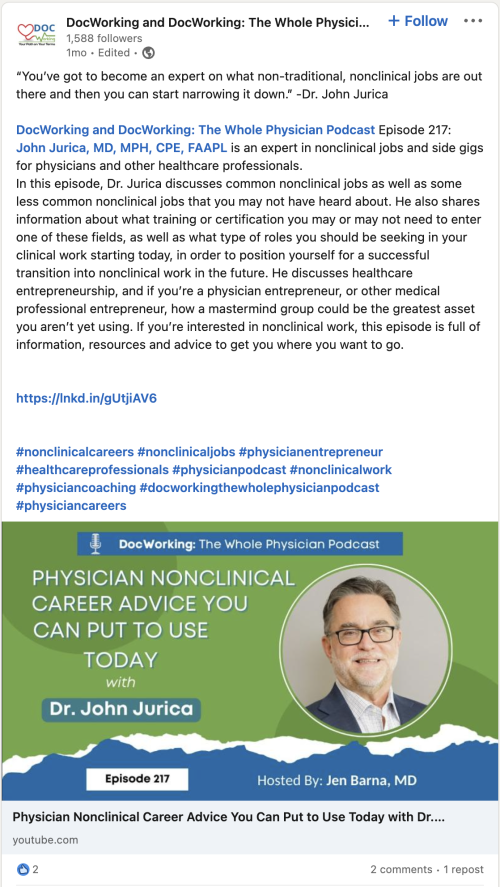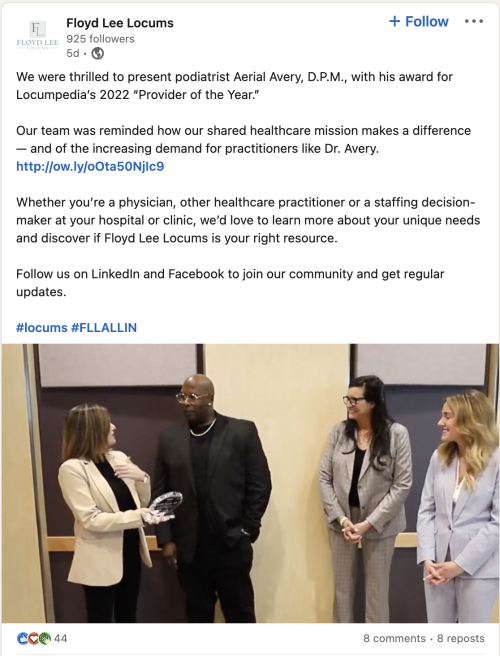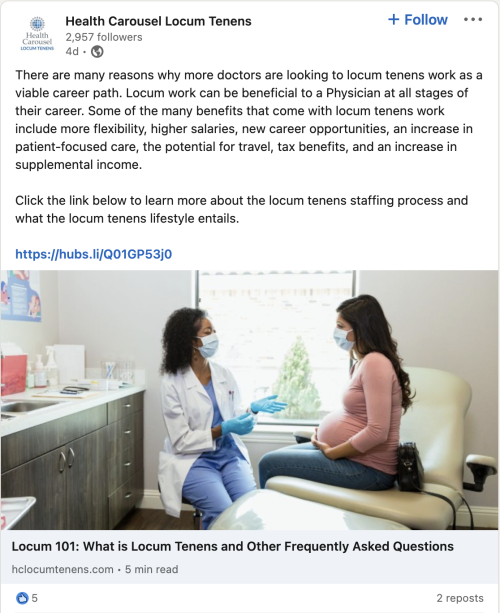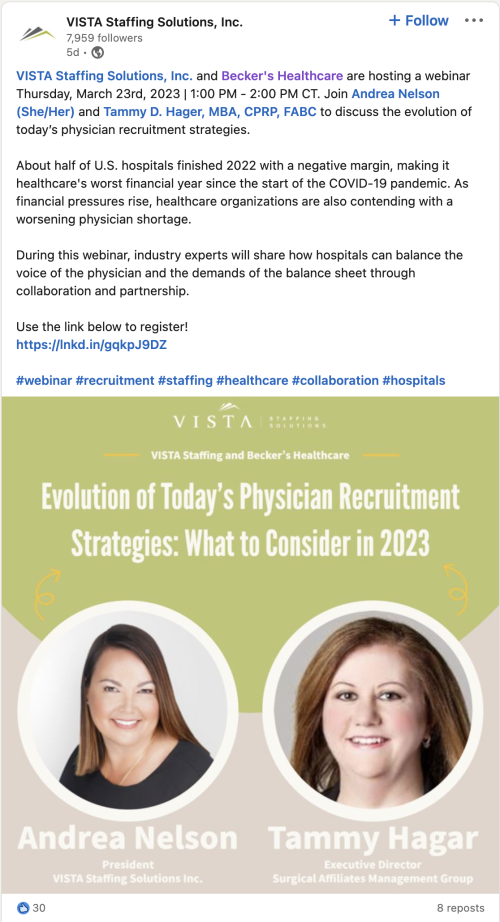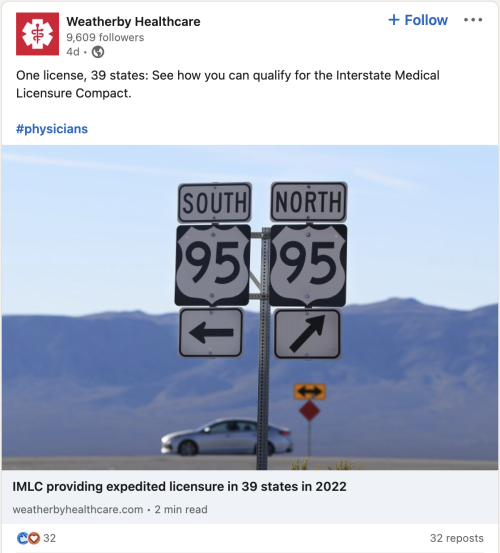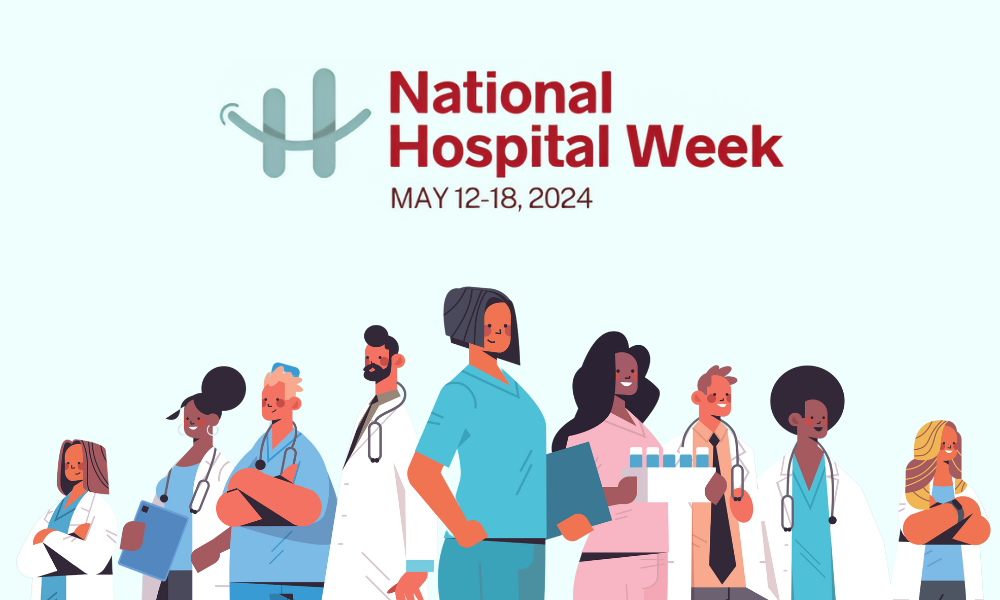In This Issue:
- AMA vs. Scope Creep: What Physicians Should Know
- The Top 5 Reasons Doctors Choose Locum Tenens
- Locum Tenens Hospitalist Thought Leader Starts a Locum Tenens Staffing Agency
- 6 Tax Tips for Locum Tenen Providers in 2023
- Choosing the Right Locum Tenens Agency for Your Needs
- Maximize Earnings & Minimize Burnout with Locum Tenens Work
- Advancing Physician Well-being through Changes in Credentialing Applications
- 3 Tips for Locum Tenens Providers to Reduce Stress and Improve Work-Life Balance
- The Price Tag of Physicians Relocating: 7 Tips to Cut Moving Costs
- How a Dollar a Day Can Transform a Physician’s Future
- Medicus Healthcare Solutions Hosts Exclusive Networking Event for Hospital Providers
- Socially Speaking: Posts of note from DocWorking, Aya Locums, Floyd Lee Locums, Health Carousel Locum Tenens & more.
- Designing Clinician-Centered Healthcare Technology
- The Medical Specialties With The Highest Caseload
AMA vs. Scope Creep: What Physicians Should Know
(From Becker’s Physician Leadership, 3/1/2023)
The American Medical Association (AMA) is taking a stand against “scope creep” — expanding non-healthcare professionals’ scope of practice in areas like pharmacy, primary care, optometry, and behavioral health. The organization outlined its position in its Recovery Plan for America’s Physicians.
With the healthcare industry facing numerous challenges, such as physician shortages, burnout, and the urgent need for quality patient care, healthcare organizations increasingly turn to locum tenens staffing agencies and providers as solutions.
Locum tenens staffing is crucial for expanding specialty services and delivering healthcare solutions at scale, providing flexibility in a comprehensive staffing strategy. Clinician interest in locum tenens continues due to its ability to redefine work-life balance, mitigate burnout, improve flexibility, and forge new career paths.
In a recent survey, 80% of clinicians said they are open to considering nonclinical roles on a project basis. The need for locum tenens staffing is crucial due to physician shortages and providers leaving clinical practice early due to burnout, the COVID-19 pandemic, retirement, and career changes.
Although locum tenens staffing has many benefits, the AMA has expressed concern about scope creep. Scope creep refers to healthcare providers performing tasks beyond their usual job duties.
Since 2019, the organization has opposed legislation for scope expansions. They have collaborated with 30 state medical associations to fight more than 70 bills introduced across state legislatures looking to expand the scope of practice.
The AMA survey on patient sentiment on the scope of practice found that 95% of the 1,000 participants think it is essential for a physician to be involved in diagnosis and treatment decisions. The organization has objected to proposed state legislation that would give certified registered nurse anesthetists in New Jersey the ability to provide anesthesia without a physician.
While some professional organizations have criticized the AMA’s efforts to counter scope creep, the organization has had legislative victories in states such as Alabama, Colorado, Hawaii, Indiana, Kentucky, Louisiana, Maryland, Missouri, Mississippi, South Dakota, Tennessee, Washington, and Wisconsin.
The American Academy of Physician Associates (AAPA) has criticized the AMA’s fight against scope creep, arguing that professional healthcare organizations must work together to solve current healthcare challenges.
The healthcare industry faces several challenges that require innovative solutions. Two potential solutions to these challenges are the increased utilization of contingent labor, such as locum tenens, and the AMA’s efforts to counteract scope creep.
By working together, organizations can ensure patients have access to high-quality care and are positioned for long-term wellness networks. This collaborative effort can also enrich the workday.
Your Locums Prescription
(From Consilium Staffing, 3/2/2023)
A Consilium Staffing blog post shares that more than 85% of healthcare facilities regularly use locum tenens providers. This number is expected to continue rising.
Locum tenens was once considered an “alternative” model in the healthcare industry but has grown to be a multi-billion dollar industry offering a tremendous career opportunity for physicians. The industry is forecasted to have the highest compound annual growth rate in healthcare staffing over the next eight years.
As the locum tenens industry continues to grow, more and more physicians are choosing this career path. Here are the five reasons why:
1. Flexibility
Locum tenens allows providers to take assignments that last a few days or months and select the ones that meet their professional and personal goals based on their schedules and commitments.
2. Patient-centric Practices
Locum tenens providers can work outside essential bureaucratic duties to focus solely on patient care.
3. Extra Income
Depending on the practice and specialty, locum positions can pay more hourly than salaried positions. Additionally, locums work allows providers to pick up extra shifts or assignments to make additional income or save vacation time to help provide medical care to underserved areas.
4. Try Before You Buy
Locum tenens allows providers to try out different practice areas and geographic locations before selecting a permanent career. This variety helps to expand their healthcare experience, broaden their professional network, and add interest to the workday.
5. Fulfillment
Locum tenens providers are heavily used in underserved areas, where healthcare providers and practice areas can be limited. Providers like being considered a blessing or lifesaver in a contract position.
Experts cite anesthesia, primary care, surgical-based specialties, and behavioral health as practice areas with increasing demand for locum tenens. While the nimble model offered by locum tenens has undoubtedly provided an advantage for healthcare facilities, doctors remain at the heart of why locum tenens has become such a sought-after profession.
(From The Locum Tenens Guy, 3/7/2023)
The “Locum Tenens Guy,” hospitalist Vlad Dzhashi, MD, announced recently in his email newsletter the launch of his own locum tenens staffing agency WhiteCoat Locums. As a physician-owned agency, the firm prioritizes the needs and goals of its healthcare providers.
For years, Dr. Dzhashi has used locum tenens for flexibility, allowing him to work 160 hospitalist shifts a year and take extended breaks with his family during the summer. He recommends locum tenens as a “try-before-you-buy” option, one that provides high income and maximum work-life balance.
WhiteCoat Locums’ mission is to offer the highest-paid locum tenens opportunities for providers, regardless of specialty or location preference. The firm offers competitive pay rates, fixed agency fees, malpractice insurance coverage, licensing, credentialing assistance, and travel expense coverage. To date, the agency has also partnered with several hospital systems nationwide.
(From Cross Country Locums. 2/27/2023)
Cross Country Locums shares in a blog post how tax season can be complicated for new locum tenens providers, especially if they are self-employed for the first time.
However, after the first year, things should be smoother with the help of a tax advisor. These 2023 tax tips for locum tenens providers, who qualify as independent contractors, will guide you.
To learn more about how tax season differs for locum tenens clinicians, check out Locumpedia’s No B.S. Guide to Locum Tenens, Part 5. This part of our guide details the differences between being paid as an employee versus being paid as an independent contractor.
To navigate tax season successfully and ensure eligibility, you will want to consult with an accountant and refer to the IRS website.
Here are some additional locum tenens provider tax tips:
- Hire an accountant to get advice on structuring yourself as a sole proprietorship, limited liability corporation, or S-Corp. An accountant can navigate complex tax codes and save you money. You are better off outsourcing your tax preparation.
- Record your monthly payments, report all income to the IRS, and confirm that the 1099s you receive from companies you contract with match your records.
- Keep track of and deduct business-related expenses but ensure you are legally entitled to all the deductions. To avoid red flags that trigger an audit, follow the law.
- Pay your quarterly estimated taxes, including income tax, self-employment tax, and alternative minimum tax. Based on your income from the previous year, your accountant can assist you in estimating your taxes for the upcoming year.
- Consider using retirement and health savings accounts like traditional IRAs, Roth IRAs, Simplified Employee Pension (SEP) IRAs, and Health Savings Accounts (HSAs) to save on taxes.
- File any relevant state taxes when you file federal taxes. An accountant who has experience with independent contractors or locum providers and understands tax laws in the states you work in will be helpful.
According to the IRS, most locum tenens providers are considered self-employed independent contractors. As an independent contractor, you must be self-employed and pay self-employment tax.
Find a complete list of possible tax deductions here. Be sure to do further research and verify deductions with your accountant.
(From CompHealth, 3/9/2023)
A CompHealth blog post offers guidance for healthcare providers who want to explore locum tenens but are unsure how to begin their journey.
The crucial first step is selecting the most suitable locum tenens agency that aligns with your objectives and requirements. But with so many agencies to choose from, it can be overwhelming.
To help inform your agency search, here are five valuable recommendations from seasoned locum professionals to help you find the perfect fit.
1. Find a locum recruiter you click with.
Your recruiter should be reliable and professional, but it’s also essential to have a recruiter with whom you have a good rapport.
2. Check the agency’s job listings.
Review the potential agency’s current job options to determine if their geographic bias aligns with your interests.
3. Consider how much the agency helps with licensing.
Find an agency to assist with licensing requirements, as administrative hurdles can significantly hinder locum tenens work.
4. Ask and understand your payment plan.
Choose an agency that aligns with what you hope to get out of your locum tenens assignment.
While many agencies pay locum providers as 1099 contractors, some may consider them W-2 employees. If able to opt as a W-2 employee, you could access health insurance, 401(k) contributions, and continuing education reimbursement.
It is crucial to inquire about the agency’s payment process and schedule. It is also recommended to ask about their policy if you cannot finish the assignment.
5. Choose an agency with a solid reputation.
Prioritize agencies prioritizing the locum tenens provider, and talk to others with experience to learn about an agency’s overall reputation.
The first step to reaping the benefits of better pay, diverse work options, and flexible travel opportunities is choosing a locum tenens agency. Take your time with this decision – follow the advice of experienced locum providers, and finding the right agency will be a breeze.
Physician Wellness Retreat
(From Hayes Locums, 3/6/2023)
Healthcare providers are experiencing burnout at an alarming rate, with almost two-thirds affected, according to a blog post by Hayes Locums.
The“2023 U.S. Physician Burnout and Depression Report” by Medscape reveals that 53% of physicians report feeling burnt out, and a significant majority of them have been experiencing burnout for over a year. Specialties such as emergency medicine, internal medicine, pediatrics, OB/GYN, and infectious disease medicine have even higher rates of burnout.
To tackle this issue, healthcare facilities use locum tenens to fill gaps in care or cover vacancies until a full-time provider is found. Taking a locum tenens assignment can reduce physician burnout by providing a work-life balance, less administrative burden, more patient interaction time, and higher pay rates.
Taking Control of Your Schedule
Working as a locum tenens physician allows for a more flexible schedule, including slowing down without completely stopping work. It can also serve as a transition between full-time positions, allowing physicians to explore different roles and practice environments before committing to a new job. By taking a locums assignment, physicians can reduce their administrative workload, which leaves more time for them to focus on the aspects of medicine they enjoy the most.
Less Administrative Burden & More Patient Time
Moreover, thanks to the reduced administrative burden, locum tenens physicians have more time to devote to patient care. Helping providers to reconnect with their original passion for medicine.
Minimizing Burnout for Maximum Earnings
Locum tenens pay rates are higher due to the increasing physician shortages, making it a lucrative option for physicians looking for a change. By spreading out the workload of patient care, understaffing — the primary driver of burnout – can be reduced.
All in all, locum tenens can be a lifesaver for physicians struggling with burnout, allowing them to recharge, explore new opportunities, and rediscover their love for medicine.
(From American Medical Association, 2/28/2023)
A nationwide effort to remove stigmatizing mental health questions from state licensing and credentialing applications used by medical groups, hospitals, and health plans is gaining momentum. The goal is to remove the barriers that deter physicians from getting the necessary care.
Previously, the credentialing application included a question asking physicians to disclose whether they had ever received mental health care, contributing to about 40% of physicians being reluctant to seek proper medical care for mental health treatment. Psychiatrist Lisa MacLean, MD, led the effort to change the question on the credentialing application at Henry Ford Health, where she is the chief clinical wellness officer.
The AMA and the Dr. Lorna Breen Heroes Foundation assisted in the process and continue to work with other interested health systems to audit questions and recommend changes. Dr. MacLean recommends using the “Remove Intrusive Mental Health Questions from Licensure and Credentialing Applications: A Toolkit to Audit, Change, and Communicate” developed by the Dr. Lorna Breen Heroes Foundation.
As part of the “Debunking Regulatory Myths” series, the AMA addressed licensing and credentialing bodies’ inquiries about physician mental health. The AMA also developed an issue brief to provide advocacy and other resources to help support mental health and wellness.
Similarly, the AMA policy encourages state licensing boards to exclude from license application forms information that refers to psychoanalysis, counseling, or psychotherapy required or undertaken as part of medical training.
Georgia is the latest state whose medical board has taken steps in this direction, changing its licensure applications to ask only about current impairment.
The Physician Burnout policy focuses on physician well-being. Hospitals and other stakeholders are encouraged to remove “intrusive questions regarding a physical or mental health or related treatments on initial or renewal hospital credentialing applications.”
The AMA continues to advocate the removal of questions regarding physician physical or mental health or related treatments on initial or renewal hospital credentialing applications.
Health systems that change their credentialing applications to focus only on current impairment rather than past diagnosis are encouraged to share that information with the AMA Advocacy Resource Center.
This move will help address clinician burnout and promote mental health care while protecting patients from potentially impaired professionals.
(From MPLT Healthcare, 3/10/2023)
Healthcare providers may struggle to maintain a balance between their patients’ needs and their personal lives. To assist locum tenens providers in managing their time and reducing stress, MPLT Healthcare shares in a blog post three stress management tips:
1. Invest in Yourself: Professional development opportunities can help healthcare providers sharpen their skills and expand their credentials. This boosts confidence at work and helps take on broader locum tenens assignments and practice settings.
2. Take Control of Your Schedule: Before accepting an assignment, assess if the job will work with personal commitments and family obligations. Adjusting work schedules throughout the year based on work-life balance needs can reduce stress levels and leave healthcare providers more in control of their professional and personal lives.
3. Make Time for Yourself: Prioritizing physical and mental health, from proper nutrition to sufficient exercise, can ensure the highest level of performance on locum tenens assignments. It also allows for optimal patient care, making locum tenens work more rewarding in the long run.
By following these tips, healthcare providers can feel more empowered while achieving a higher quality of life at work and at home.
Tools to Try/News to Use
(From White Coat Investor, 2/22/2023)
White Coat Investor shares how the American Association of Medical Colleges (AAMC) tracks the migratory patterns of young physicians post-graduation, revealing fascinating insights about physicians’ career mobility. Reasons for moving can include military service, working overseas or in rural settings, or locum tenens work.
Moving Is Expensive
However, moving is costly, and physicians may need to move multiple times during their careers.
Moving costs have increased due to rising labor and supply costs and higher demand caused by the pandemic and remote work. As interest rates rise and the economy stabilizes, there may be some relief from these cost increases.
For physicians, who accumulate household items over time, costs can add up quickly, particularly for cross-country moves, which can cost around $1 per pound in freight costs alone.
7 Ways to Mitigate Moving Costs
Moving can be pricey, but there are ways to alleviate the financial burden. Here are seven ways to save money while relocating:
1. Do It Yourself (DIY): This option is the cheapest but requires hard work. Borrowing a friend’s truck and recycling boxes can reduce costs.
2. Relocation Allowance: Many employers offer a comprehensive relocation package. The extent of the budget depends on the location’s desirability and competitiveness of the specialty.
3. Partial DIY: Pack yourself and have others ship and unpack.
4. Donate and Consider Taxes: Unload unwanted possessions and keep the receipts as donations are tax-deductible.
5. Select Down Dates: Moving in the fall or winter is often cheaper than in late spring or summer.
6. Recycle Moving Goods: Used packing supplies can be found online.
7. Look for Discounts: There are many discounts available for movers, including those for military members, AAA members, and healthcare workers.
Moving can be expensive and stressful, but planning for contingencies and accepting the unexpected can help make it successful financially and emotionally.
(From Physician On Fire, 3/14/2023)
The 2022 White Coat Investor Conference sparked curiosity in the author of this Physician on Fire news post. The author wondered how much additional savings and investments would be needed to spend an extra dollar daily during retirement.
After snacking on a packet of Planters Spicy Nuts and Cajun Sticks at the conference, the author wondered about the cost of indulging in this treat daily without feeling guilty. A quick online search revealed that a dollar a day would suffice, and a bulk pack of 72 pieces could be purchased for less than $40 of CamelCamelCamel.
Ultimately, the author opted to buy the snack in bulk at slightly more than 50 cents apiece.
The Less Than $64,000 Question
The 4% rule of thumb is commonly used by retirees. The rule suggests saving 25 times the amount you plan to spend annually in retirement.
If you invest this money in a diverse range of stocks and bonds, your odds of running out of money are low, and you may end up with more than you started with.
To afford an extra dollar daily snack during retirement, you must save around $10,000 and invest it. However, adding unhealthy snacks to your diet without making other adjustments could harm your health and not be the best strategy for a successful retirement.
It’s Easy Mental Math
In order to have an additional dollar per day during retirement, you will need about $10,000. So $100,000 will give you $10 a day, and $1,000,000 is worth $100 a day. With a nest egg of $2,500,000 to $3,000,000, you can spend $250 to $300 daily without violating the 4% rule.
It’s Achievable
Starting your retirement savings can be daunting if you need to be closer to your goal, but having a net worth of $10,000 can give you a dollar a day towards retirement. This progress can motivate you to keep going.
The Power of One More Year
Each year of work where you save and invest $10,000 can increase your daily budget by one dollar and shorten your retirement by one month.
Working Backward
To change their perspective on spending in retirement, retirees should consider the value of $10,000 as one dollar a day. While it’s important to factor in all expenses and follow the 4% rule, there can still be room for “fun money” in their budget.
Every $10,000 saved can give retirees one dollar a day for life.
(From Medicus Healthcare Solutions, 3/14/2023)
Join Medicus Healthcare Solutions on March 27 from 5-7 p.m. at the Hilton Austin for anexclusive evening of networking, cocktails, and appetizers at the prestigious Cannon + Belle.
This event is for hospital medicine physicians, advanced practice providers, residents, and fellows. Expand your network and indulge in a delightful evening with like-minded professionals.
Doctor’s Notes
(From Medical Economics, 2/28/2023)
In a Medical Economics news story, the ECRI Institute named clinician burnout a significant patient safety concern. Although not surprising to clinicians, the report’s language was noteworthy. Clinician burnout is a public health crisis affecting clinicians, their families, patients, organizations, and communities. It can result in experienced clinicians leaving the field earlier than they would have and discouraging the next generation from pursuing healthcare.
Systematic ways to eliminate unnecessary hassles, reduce administrative burdens, and alleviate stress and cognitive overload for physicians and nurses are necessary to address clinician burnout. Simplifying complex workflows could save care teams valuable time providing direct patient care.
Additionally, establishing a “metric for humanity” to evaluate the impact of new processes or technology on clinicians’ ability to care is necessary.
The Role Technology Plays
To create a connected healing ecosystem of people, processes, and technologies, define human-centered innovations and implementation practices. Technology enables clinicians to communicate and share information without diverting their attention from patient care.
However, the improper management of test results in electronic health records (EHRs) is a significant patient safety concern. EHRs have made it burdensome for clinicians, turning them into data entry clerks and creating a barrier between them and their patients.
The right technology can facilitate human connections at every stage of care and should be co-designed with patients and clinicians to avoid becoming a hindrance.
Elevate the voices of clinicians and patients
Clinician burnout is a system issue, not an individual one. Co-design the next generation of healthcare technologies with clinicians and patients to eliminate the preventable trauma caused by complex and fatiguing systems. Voice technology that humanizes healthcare connects highly mobile care teams, and returns people to their purpose is the future of caring.
Organizations should recognize the benefits of involving clinicians and patients in innovation design. Product engineers and IT leaders should listen to physicians, nurses, and patients to develop human-centered innovations that improve the lives of patients, families, and care teams.
(From Becker’s ASC Review, 3/3/2023)
The healthcare workforce experienced a loss of 333,942 providers between 2020 and 2021, resulting in a continued shortage of healthcare professionals. The remaining physicians are under more pressure due to increased service demand.
According to a report released on December 31, 2021, by the Association of American Medical Colleges, the most recent data shows that, on average, 344 patients per physician across all specialties.
The report also shows how many patients each physician sees in different specialties. Pulmonary medicine has the highest caseload, with 67,099 patients per physician, followed by allergy and immunology, 65,197 patients per physician, and rheumatology, 60,867 patients per physician. Pediatrics has the lowest caseload, with 1,720 patients per physician.
View the complete list of specialties and their corresponding caseloads here.




